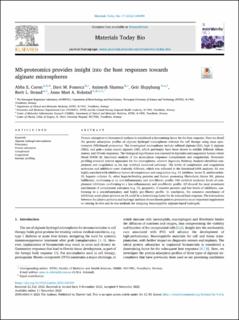| dc.contributor.author | Coron, Abba Elizabeth | |
| dc.contributor.author | Fonseca, Davi de Miranda | |
| dc.contributor.author | Sharma, Animesh | |
| dc.contributor.author | Slupphaug, Geir | |
| dc.contributor.author | Strand, Berit Løkensgard | |
| dc.contributor.author | Rokstad, Anne Mari A. | |
| dc.date.accessioned | 2022-11-25T07:56:37Z | |
| dc.date.available | 2022-11-25T07:56:37Z | |
| dc.date.created | 2022-11-14T08:52:28Z | |
| dc.date.issued | 2022 | |
| dc.identifier.issn | 2590-0064 | |
| dc.identifier.uri | https://hdl.handle.net/11250/3033994 | |
| dc.description.abstract | Protein adsorption to biomaterial surfaces is considered a determining factor for the host response. Here we detail the protein adsorption profiles of alginate hydrogel microspheres relevant for cell therapy using mass spectrometry (MS)-based proteomics. The investigated microspheres include sulfated alginate (SA), high G alginate (HiG), and poly-l-lysine coated alginate (AP), which previously have been shown to exhibit different inflammatory and fibrotic responses. The biological significance was assessed in lepirudin-anticoagulated human whole blood (hWB) by functional analysis of the acute phase responses (complement and coagulation). Proteomic profiling revealed distinct signatures for the microspheres, wherein Ingenuity Pathway Analysis identified complement and coagulation as the top enriched canonical pathways. The levels of complement and coagulation activators and inhibitors were distinctly different, which was reflected in the functional hWB analyses: SA was highly enriched with inhibitory factors of complement and coagulation (e.g., C1 inhibitor, factor H, antithrombin-III, heparin cofactor 2), other heparin-binding proteins and factors promoting fibrinolysis (factor XII, plasma kallikrein), conforming to an anti-inflammatory and anti-fibrotic profile. HiG enriched moderate levels of complement inhibitors, conforming to a low-inflammatory and pro-fibrotic profile. AP showed the most prominent enrichment of complement activators (e.g., C3, properdin, C-reactive protein) and low levels of inhibitors, conforming to a pro-inflammatory and highly pro-fibrotic profile. In conclusion, the extensive enrichment of inhibitory acute phase proteins on SA could be a determining factor for its reduced host response. The interactions between the plasma proteins and hydrogel surfaces shown herein point to proteomics as an important supplement to existing in vitro and in vivo methods for designing biocompatible alginate-based hydrogels. | en_US |
| dc.description.abstract | MS-proteomics provides insight into the host responses towards alginate microspheres | en_US |
| dc.language.iso | eng | en_US |
| dc.publisher | Elsevier | en_US |
| dc.relation.uri | https://www.sciencedirect.com/science/article/pii/S2590006422002885?via%3Dihub | |
| dc.rights | Navngivelse 4.0 Internasjonal | * |
| dc.rights.uri | http://creativecommons.org/licenses/by/4.0/deed.no | * |
| dc.title | MS-proteomics provides insight into the host responses towards alginate microspheres | en_US |
| dc.title.alternative | MS-proteomics provides insight into the host responses towards alginate microspheres | en_US |
| dc.type | Journal article | en_US |
| dc.type | Peer reviewed | en_US |
| dc.description.version | publishedVersion | en_US |
| dc.source.journal | Materials Today Bio | en_US |
| dc.identifier.doi | 10.1016/j.mtbio.2022.100490 | |
| dc.identifier.cristin | 2073148 | |
| dc.relation.project | Norges teknisk-naturvitenskapelige universitet: Faculty of Natural Science | en_US |
| dc.relation.project | Samarbeidsorganet mellom Helse Midt-Norge og NTNU: 46056819 | en_US |
| dc.relation.project | Norges teknisk-naturvitenskapelige universitet: NTNU health "Tailored biomaterials" | en_US |
| dc.relation.project | Norges forskningsråd: 223255 | en_US |
| cristin.ispublished | false | |
| cristin.fulltext | original | |
| cristin.qualitycode | 1 | |

